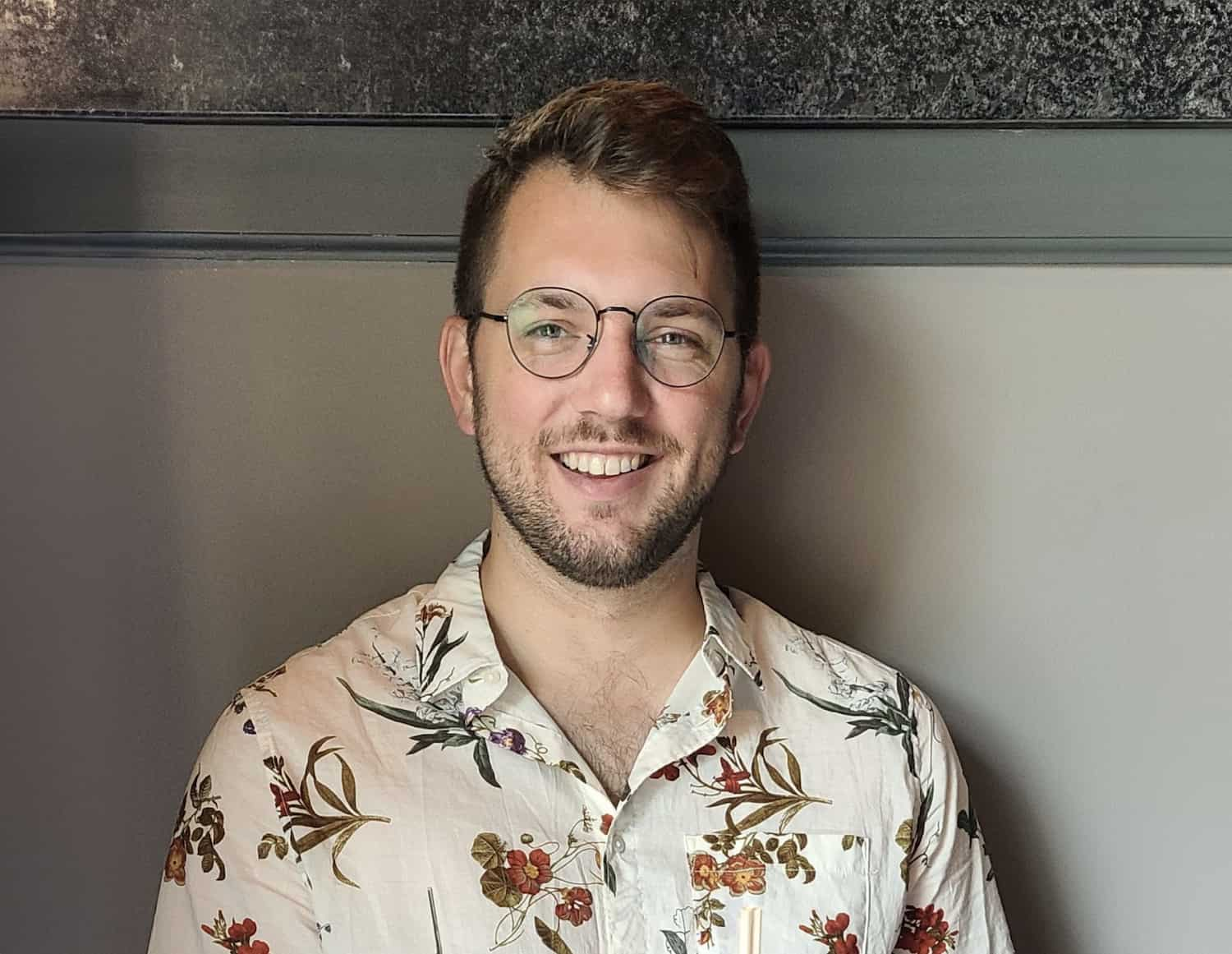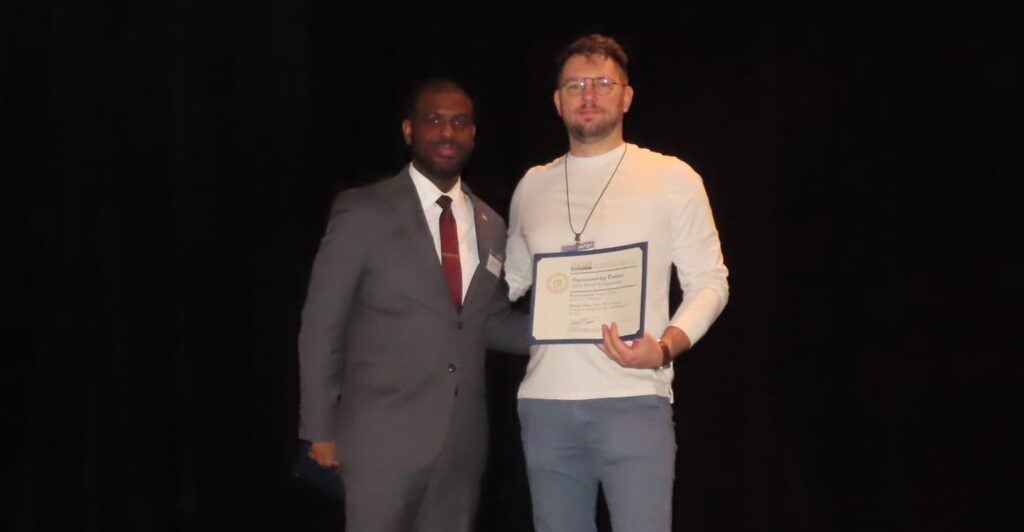
Trevor Johannes Smith receives Best Poster Award at SSAP Symposium
Trevor’s research centers on examining plasmas generated on the surface of high-current transmission lines on pulsed-power accelerators.

Trevor’s research centers on examining plasmas generated on the surface of high-current transmission lines on pulsed-power accelerators.
Trevor Johannes Smith, a graduate student in the U-M Department of Nuclear Engineering & Radiological Sciences (NERS), has been honored with a Best Poster Award at the 2024 Stewardship Science Academic Alliances (SSAA) Program Symposium held on February 21–22, 2024, in Arlington, VA. Trevor’s poster was titled, “Understanding electrode plasma formation on wires and thin foils via vacuum ultraviolet spectroscopy of desorbed surface contaminants.”
The SSAA Program, aimed at advancing scientific research relevant to national security, supports collaborative Centers of Excellence and individual investigator projects across approximately 80 universities; Trevor’s work is currently supported by the Magnetic Acceleration, Compression, and Heating (MACH) Center of Excellence led by Prof. Ryan McBride, who is also Trevor’s PhD Advisor. Trevor’s achievement highlights the caliber of research emerging from the department and its alignment with the core mission of the National Nuclear Security Administration (NNSA).
“Trevor’s work is helping to answer important questions about how plasma forms along high-power electrode surfaces,” said McBride. “If too much plasma forms, the machine’s electrical current could be diverted away from the intended target, causing the system to ‘short out.’ Understanding these processes is important for the research conducted on today’s 20 to 30 million ampere Z facility at Sandia National Laboratories. Additionally, the NNSA labs want to ensure that a Next Generation Pulsed Power (NGPP) facility will work as intended. An NGPP facility would aim to deliver more than 50 million amperes to a cm-scale target, with the goal being to achieve high-yield nuclear fusion ignition. Helping the NNSA labs answer such questions while developing outstanding students like Trevor is the main objective of the MACH Center.”

Trevor’s poster presentation delved into his research focusing on plasmas formed on the surface of high-current transmission lines, particularly on pulsed-power accelerators like the Z-machine at Sandia National Laboratories. His investigation aims to characterize the presence and type of contaminants such as water and oxides on these surfaces, which can contribute to plasma formation and subsequent current losses to targets. Trevor has developed a state-of-the-art diagnostic tool, a vacuum ultraviolet spectrometer, which measures neutral atomic and molecular hydrogen. This novel approach allows for earlier insights into plasma formation, enabling more accurate predictive models of plasma behavior.
“Different programs at Sandia that contribute to stockpile stewardship such as Dynamic Material Properties (DMP), Inertial Confinement Fusion (ICF), and Radiation Effects all rely on the Z-machine to deliver a consistent current pulse to their different target designs,” said Trevor. “This research will help answer previously unknown initial conditions to complex, nonlinear systems so that we can better predict delivered current to target regions across multiple stockpile stewardship programs. This will be increasingly important as we look to a Next Generation Pulsed Power (NGPP) facility that is aiming for three times the amount of current as today’s Z-machine facility.”
Reflecting on his achievement, Trevor said, “Winning this award is a great sign of the hard work and dedication over the past five years of my graduate research. It is great to be acknowledged that this research is impactful to the mission of the NNSA.”
“I was born and raised in Kalamazoo, Michigan and applied to the University as it was one of the best engineering schools in the country,” said Trevor. “I’ve received my Bachelors and Masters degrees from Michigan and am hoping to graduate with my doctoral degree from Michigan soon to complete my degree hat-trick.”
When he’s not in the lab, Trevor enjoys hiking, roller-blading, playing video games, and Dungeons & Dragons, and he’s always looking for new and exciting food to try. He met his fiance while he was a NERS masters student and she was a first year Michigan law student. They relocated to Albuquerque, New Mexico, almost two years ago so that Trevor could finish his doctoral research at Sandia. They also have three cats (Laszlo, Temari, and Korra) which Trevor says they, “spoil to no end.”
Trevor’s journey into nuclear science began during his undergraduate studies in the Engineering Physics program here at the University, where he found his passion for nuclear engineering and radiological sciences. Throughout his academic career, Trevor has been actively involved in promoting NERS and Engineering Physics to fellow students, volunteering his time to inspire and educate future generations of nuclear scientists and engineers.
“I always enjoy interacting with students looking to learn, ask questions, and be excited about the topic of plasma physics!” said Trevor. This affinity for student interaction likely motivated his role as a Teaching Assistant in three NERS courses, including NERS 471 (Intro to Plasmas and Fusion), NERS 472 (Fusion Reactor Technology), and NERS 590 (Professor Carolyn Kuranz’s High Energy Density Physics Special Topics course).
Looking ahead, Trevor aims to graduate with his doctoral degree and continue his research as a member of the Pulsed Power Sciences division at Sandia. His dedication to advancing the field of nuclear science and his commitment to national security underscore his aspirations for a meaningful and impactful career.
“I’d like to thank my advisor, Ryan McBride, my Sandia manager, Jens Schwarz, and my collaborators both at the University of Michigan and at Sandia for helping support this work and giving me the opportunity to have worked for the past two years out in Albuquerque at Sandia as an intern,” said Trevor. “The opportunity to perform research on leading-edge facilities with researchers at the top of their field has been an immeasurable experience to help grow my professional career.”